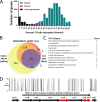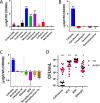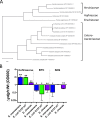A Genome-Scale Antibiotic Screen in Serratia marcescens Identifies YdgH as a Conserved Modifier of Cephalosporin and Detergent Susceptibility
- PMID: 34491801
- PMCID: PMC8597751
- DOI: 10.1128/AAC.00786-21
A Genome-Scale Antibiotic Screen in Serratia marcescens Identifies YdgH as a Conserved Modifier of Cephalosporin and Detergent Susceptibility
Abstract
Serratia marcescens, a member of the order Enterobacterales, is adept at colonizing health care environments and is an important cause of invasive infections. Antibiotic resistance is a daunting problem in S. marcescens because, in addition to plasmid-mediated mechanisms, most isolates have considerable intrinsic resistance to multiple antibiotic classes. To discover endogenous modifiers of antibiotic susceptibility in S. marcescens, a high-density transposon insertion library was subjected to sub-MICs of two cephalosporins, cefoxitin, and cefepime, as well as the fluoroquinolone ciprofloxacin. Comparisons of transposon insertion abundance before and after antibiotic exposure identified hundreds of potential modifiers of susceptibility to these agents. Using single-gene deletions, we validated several candidate modifiers of cefoxitin susceptibility and chose ydgH, a gene of unknown function, for further characterization. In addition to cefoxitin, deletion of ydgH in S. marcescens resulted in decreased susceptibility to multiple third-generation cephalosporins and, in contrast, to increased susceptibility to both cationic and anionic detergents. YdgH is highly conserved throughout the Enterobacterales, and we observed similar phenotypes in Escherichia coli O157:H7 and Enterobacter cloacae mutants. YdgH is predicted to localize to the periplasm, and we speculate that it may be involved there in cell envelope homeostasis. Collectively, our findings provide insight into chromosomal mediators of antibiotic resistance in S. marcescens and will serve as a resource for further investigations of this important pathogen.
Keywords: AmpC; Serratia marcescens; TIS; TnSeq; YdgH; cefepime; cefoxitin; cephalosporin; ciprofloxacin; fluoroquinolone.
Figures






Similar articles
-
Characterization of YdgH: a mediator of beta-lactam susceptibility in Enterobacterales.Microbiol Spectr. 2025 Jan 7;13(1):e0194024. doi: 10.1128/spectrum.01940-24. Epub 2024 Dec 10. Microbiol Spectr. 2025. PMID: 39656017 Free PMC article.
-
Screening extended-spectrum beta-lactamase production in Enterobacter cloacae and Serratia marcescens using antibiogram-based methods.J Microbiol Immunol Infect. 2010 Feb;43(1):26-34. doi: 10.1016/S1684-1182(10)60004-7. Epub 2010 Mar 29. J Microbiol Immunol Infect. 2010. PMID: 20434120
-
The lack of OmpF, but not OmpC, contributes to increased antibiotic resistance in Serratia marcescens.Microbiology (Reading). 2014 Sep;160(Pt 9):1882-1892. doi: 10.1099/mic.0.081166-0. Epub 2014 Jul 10. Microbiology (Reading). 2014. PMID: 25015362
-
Serratia marcescens antibiotic resistance mechanisms of an opportunistic pathogen: a literature review.PeerJ. 2023 Jan 5;11:e14399. doi: 10.7717/peerj.14399. eCollection 2023. PeerJ. 2023. PMID: 36627920 Free PMC article. Review.
-
Antimicrobial Treatment of Serratia marcescens Invasive Infections: Systematic Review.Antibiotics (Basel). 2023 Feb 9;12(2):367. doi: 10.3390/antibiotics12020367. Antibiotics (Basel). 2023. PMID: 36830278 Free PMC article. Review.
Cited by
-
Characterization of YdgH: a mediator of beta-lactam susceptibility in Enterobacterales.Microbiol Spectr. 2025 Jan 7;13(1):e0194024. doi: 10.1128/spectrum.01940-24. Epub 2024 Dec 10. Microbiol Spectr. 2025. PMID: 39656017 Free PMC article.
-
Divergent genetic landscapes drive lower levels of AmpC induction and stable de-repression in Serratia marcescens compared to Enterobacter cloacae.Antimicrob Agents Chemother. 2024 Jan 10;68(1):e0119323. doi: 10.1128/aac.01193-23. Epub 2023 Dec 12. Antimicrob Agents Chemother. 2024. PMID: 38084952 Free PMC article.
-
A rare case of successful treatment of peritoneal dialysis patient with Serratia marcescens peritonitis without catheter removal: case report and literature review.Front Cell Infect Microbiol. 2024 May 30;14:1373036. doi: 10.3389/fcimb.2024.1373036. eCollection 2024. Front Cell Infect Microbiol. 2024. PMID: 38873095 Free PMC article. Review.
References
-
- Adeolu M, Alnajar S, Naushad S, S Gupta R. 2016. Genome-based phylogeny and taxonomy of the ‘Enterobacteriales’: proposal for Enterobacterales ord. nov. divided into the families Enterobacteriaceae, Erwiniaceae fam. nov., Pectobacteriaceae fam. nov., Yersiniaceae fam. nov., Hafniaceae fam. nov., Morganellaceae fam. nov., and Budviciaceae fam. nov. Int J Syst Evol Microbiol 66:5575–5599. 10.1099/ijsem.0.001485. - DOI - PubMed
Publication types
MeSH terms
Substances
Grants and funding
LinkOut - more resources
Full Text Sources
Medical
Molecular Biology Databases

